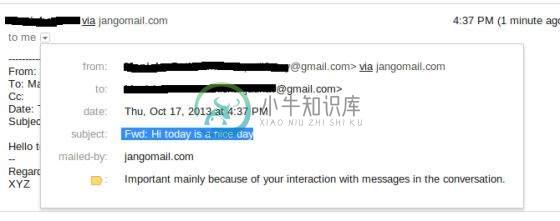转发电子邮件(Forwarding Emails)
优质
小牛编辑
134浏览
2023-12-01
在本章中,我们将了解如何使用JavaMail API转发电子邮件。 以下程序中遵循的基本步骤是:
在属性中获取具有POP和SMPT服务器详细信息的Session对象。 我们需要POP详细信息来检索消息和SMPT详细信息以发送消息。
创建POP3商店对象并连接到商店。
创建文件夹对象并在邮箱中打开相应的文件夹。
检索邮件。
如果要转发,请浏览消息并输入“Y”或“y”。
获取邮件的所有信息(收件人,发件人,主题,内容)。
通过使用组成消息的部分来构建转发消息。 第一部分是消息的文本,第二部分是要转发的消息。 将两者组合成一个多部分。 然后将多部分添加到正确寻址的消息并发送它。
分别关闭Transport,文件夹和存储对象。
在这里,我们使用了JangoSMPT服务器,通过该服务器将电子邮件发送到我们的目标电子邮件地址。 环境设置章节中介绍了该设置 。
创建Java类 (Create Java Class)
创建一个java类文件ForwardEmail ,其内容如下:
package cn.xnip;
import java.io.BufferedReader;
import java.io.InputStreamReader;
import java.util.Date;
import java.util.Properties;
import javax.mail.BodyPart;
import javax.mail.Folder;
import javax.mail.Message;
import javax.mail.Multipart;
import javax.mail.PasswordAuthentication;
import javax.mail.Session;
import javax.mail.Store;
import javax.mail.Transport;
import javax.mail.internet.InternetAddress;
import javax.mail.internet.MimeBodyPart;
import javax.mail.internet.MimeMessage;
import javax.mail.internet.MimeMultipart;
public class ForwardEmail {
public static void main(String[] args) {
Properties properties = new Properties();
properties.put("mail.store.protocol", "pop3");
properties.put("mail.pop3s.host", "pop.gmail.com");
properties.put("mail.pop3s.port", "995");
properties.put("mail.pop3.starttls.enable", "true");
properties.put("mail.smtp.auth", "true");
properties.put("mail.smtp.host", "relay.jangosmtp.net");
properties.put("mail.smtp.port", "25");
Session session = Session.getDefaultInstance(properties);
try {
// session.setDebug(true);
// Get a Store object and connect to the current host
Store store = session.getStore("pop3s");
store.connect("pop.gmail.com", "xyz@gmail.com",
"*****");//change the user and password accordingly
// Create a Folder object and open the folder
Folder folder = store.getFolder("inbox");
folder.open(Folder.READ_ONLY);
BufferedReader reader = new BufferedReader(new InputStreamReader(
System.in));
Message[] messages = folder.getMessages();
if (messages.length != 0) {
for (int i = 0, n = messages.length; i < n; i++) {
Message message = messages[i];
// Get all the information from the message
String from = InternetAddress.toString(message.getFrom());
if (from != null) {
System.out.println("From: " + from);
}
String replyTo = InternetAddress.toString(message
.getReplyTo());
if (replyTo != null) {
System.out.println("Reply-to: " + replyTo);
}
String to = InternetAddress.toString(message
.getRecipients(Message.RecipientType.TO));
if (to != null) {
System.out.println("To: " + to);
}
String subject = message.getSubject();
if (subject != null) {
System.out.println("Subject: " + subject);
}
Date sent = message.getSentDate();
if (sent != null) {
System.out.println("Sent: " + sent);
}
System.out.print("Do you want to reply [y/n] : ");
String ans = reader.readLine();
if ("Y".equals(ans) || "y".equals(ans)) {
Message forward = new MimeMessage(session);
// Fill in header
forward.setRecipients(Message.RecipientType.TO,
InternetAddress.parse(from));
forward.setSubject("Fwd: " + message.getSubject());
forward.setFrom(new InternetAddress(to));
// Create the message part
MimeBodyPart messageBodyPart = new MimeBodyPart();
// Create a multipart message
Multipart multipart = new MimeMultipart();
// set content
messageBodyPart.setContent(message, "message/rfc822");
// Add part to multi part
multipart.addBodyPart(messageBodyPart);
// Associate multi-part with message
forward.setContent(multipart);
forward.saveChanges();
// Send the message by authenticating the SMTP server
// Create a Transport instance and call the sendMessage
Transport t = session.getTransport("smtp");
try {
//connect to the smpt server using transport instance
//change the user and password accordingly
t.connect("abc", "*****");
t.sendMessage(forward, forward.getAllRecipients());
} finally {
t.close();
}
System.out.println("message forwarded successfully....");
// close the store and folder objects
folder.close(false);
store.close();
}// end if
}// end for
}// end if
} catch (Exception e) {
e.printStackTrace();
}
}
}
您可以通过取消注释语句session.setDebug(true);来设置调试session.setDebug(true);
编译和运行 (Compile and Run)
现在我们的课已经准备好了,让我们编译上面的类。 我已将类ForwardEmail.java保存到目录: /home/manisha/JavaMailAPIExercise 。 我们需要在类路径中使用jars javax.mail.jar和activation.jar 。 执行以下命令从命令提示符编译类(两个jar放在/ home/manisha /目录中):
javac -cp /home/manisha/activation.jar:/home/manisha/javax.mail.jar: ForwardEmail.java
现在编译了类,执行以下命令来运行:
java -cp /home/manisha/activation.jar:/home/manisha/javax.mail.jar: ForwardEmail
验证输出 (Verify Output)
您应该在命令控制台上看到以下消息:
From: ABC <abc@gmail.com>
Reply-to: abc@trioteksolutions.com
To: XYZ <xyz@gmail.com>
Subject: Hi today is a nice day
Sent: Thu Oct 17 15:58:37 IST 2013
Do you want to reply [y/n] : y
message forwarded successfully....
检查邮件发送到的收件箱。 在我们的例子中,转发的消息如下所示:



